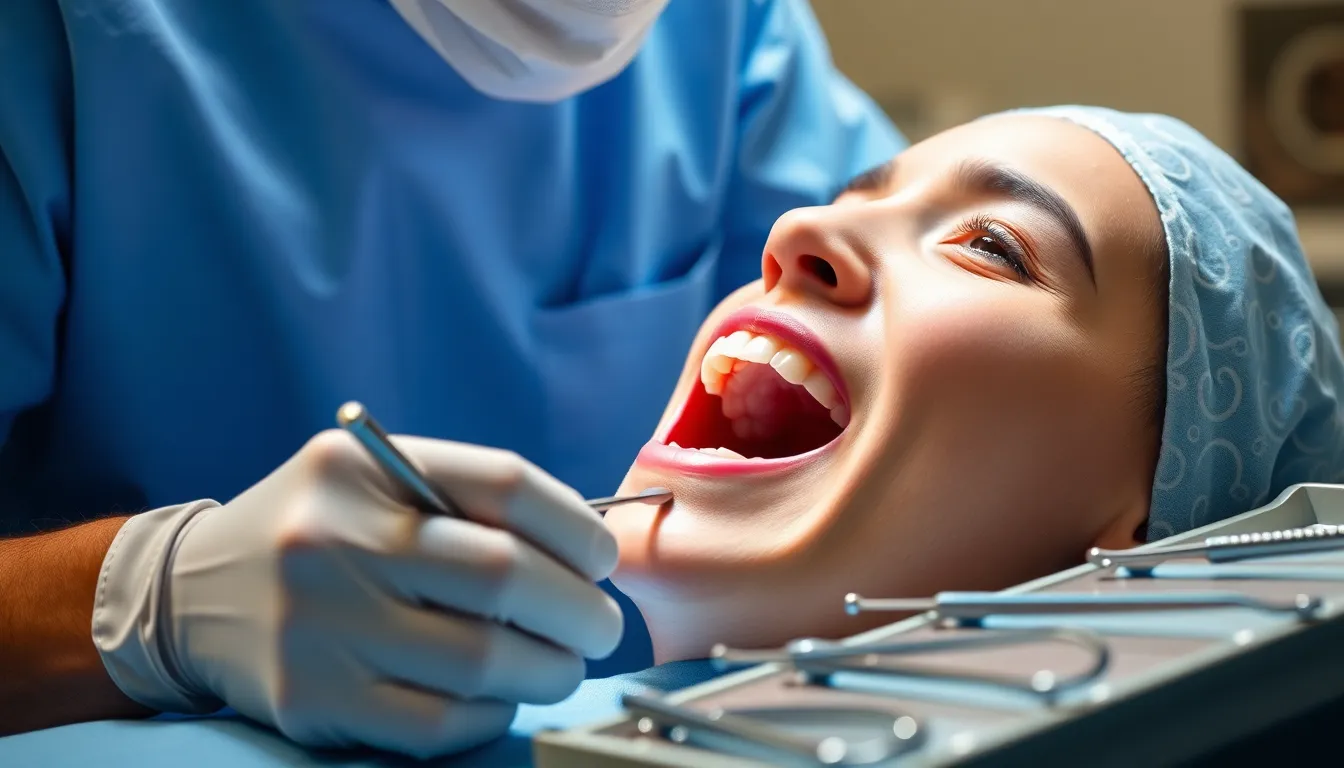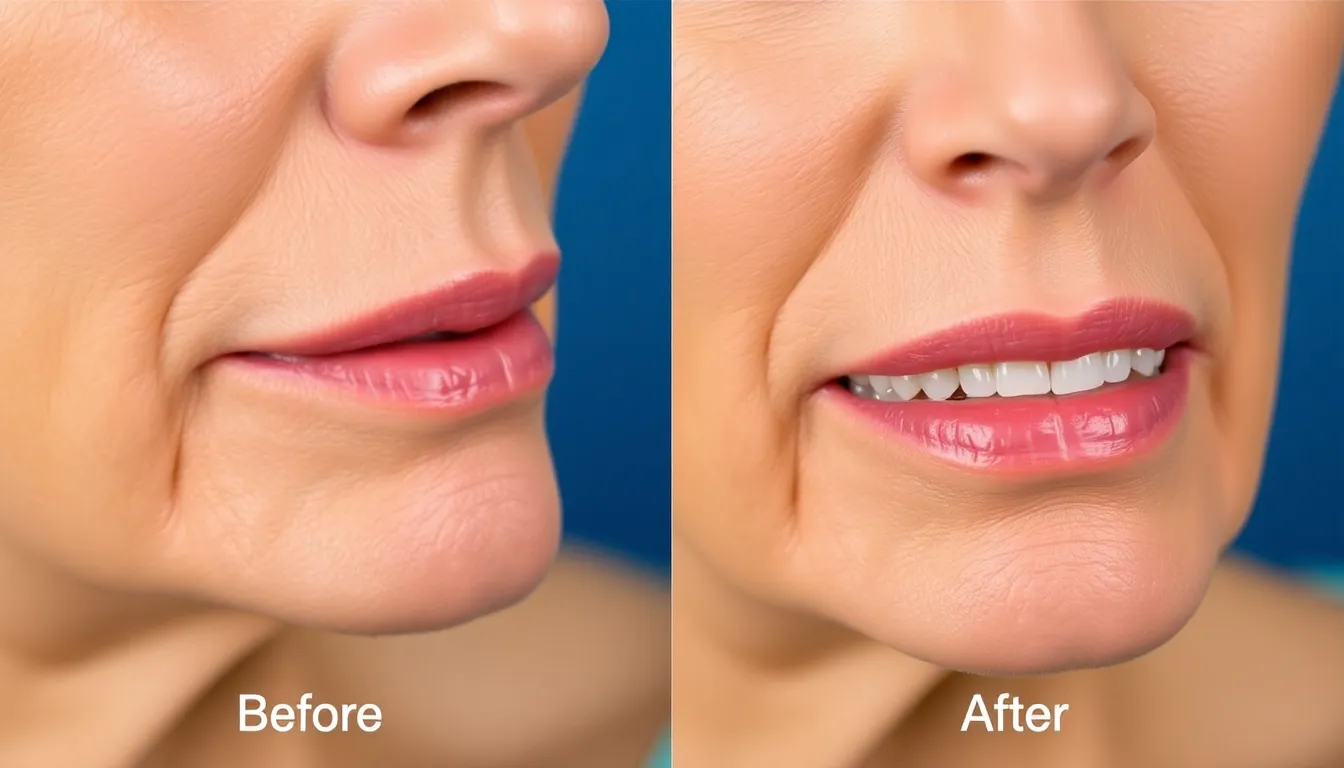Considering a sinus lift but unsure what to expect before and after the procedure? This bone grafting technique can be life-changing for those seeking dental implants but lacking sufficient bone in their upper jaw.
A sinus lift creates space for new bone by gently raising the sinus membrane, paving the way for successful implant placement. The transformation between pre-procedure limitations and post-recovery results can be remarkable, with patients experiencing improved facial structure and renewed confidence in their smile. You’ll find that understanding the typical sinus lift journey—from initial consultation through healing and final results—helps set realistic expectations for your own dental restoration path.
What Is a Sinus Lift Procedure?
A sinus lift procedure is a specialized dental surgery that adds bone to your upper jaw in the area of your molars and premolars. This surgical technique elevates the sinus membrane, creating space for new bone material between your jaw and maxillary sinuses.
Why Sinus Lifts Are Necessary
Sinus lifts become necessary when there’s insufficient bone height in the upper jaw for dental implants. Bone loss occurs for several reasons: periodontal disease, tooth loss causing bone resorption, or naturally large sinus cavities. The maxillary sinuses are air-filled spaces that sit directly above your upper molars and premolars, and when teeth are removed in this area, only a thin wall of bone remains between the mouth and sinus.
Many patients come to our office concerned about their ability to get implants after years of missing teeth. Sarah, a 58-year-old patient, had lost her upper molars nearly a decade ago and was told she couldn’t get implants due to bone loss. After a successful sinus lift, she gained enough bone volume for three implants, completely restoring her chewing function.
Dental implants require firm anchoring in substantial bone tissue (typically 5-7mm minimum), making sinus lifts essential for patients with inadequate upper jaw bone. The procedure also helps prevent future bone loss, protecting adjacent teeth and maintaining facial structure integrity.
Types of Sinus Lift Procedures
Two primary sinus lift techniques are used in modern dentistry: lateral approach and crestal approach. The lateral approach involves creating a small window in the side wall of the maxillary sinus, then carefully lifting the membrane before placing bone graft material. This technique works well for cases requiring important bone augmentation, typically adding 5-10mm of vertical height.
The crestal approach (or osteotome technique) is less invasive, accessing the sinus floor through the site where the implant will be placed. Using specialized instruments, the surgeon gently fractures the sinus floor and elevates the membrane, creating space for bone grafting material. This approach is suitable for cases needing modest bone height increases of 2-4mm.
Dr. Harris often prefers the crestal approach for compatible cases because it reduces recovery time and discomfort. “For many patients with moderate bone loss, we can perform the sinus lift and place implants in a single procedure,” notes Dr. Harris. “This significantly shortens the overall treatment timeline while delivering excellent outcomes.”
Each procedure type uses various grafting materials including autogenous bone (from your own body), allografts (processed human donor bone), xenografts (animal-derived bone), or synthetic materials. The choice depends on your exact anatomy, bone quality, and treatment goals.
Preparing for Your Sinus Lift Surgery

Proper preparation for a sinus lift procedure ensures optimal results and a smoother recovery. The preparation phase includes comprehensive medical evaluations and exact pre-operative guidelines that help minimize complications and maximize success rates.
Medical Evaluation and Planning
A thorough medical assessment forms the foundation of a successful sinus lift surgery. Your dental specialist will conduct detailed X-rays and CT scans to evaluate the current condition of your jawbone and sinus cavity structure. These imaging techniques provide critical information about bone density, sinus dimensions, and anatomical features that affect surgical planning. During your consultation, your specialist will discuss your dental health objectives and develop a customized surgical approach based on your existing bone quantity and exact requirements. The planning phase often involves creating precise measurements for the amount of bone graft material needed to achieve adequate height for future implant placement.
Pre-Operative Instructions
Several important guidelines must be followed before your scheduled sinus lift procedure. Your dentist will provide exact instructions about medications, including which ones to continue, discontinue, or adjust before surgery. Dietary restrictions typically include avoiding food and drinks for a certain period before the procedure, particularly if you’ll be receiving sedation. On the day of surgery, you’ll receive either local anesthesia or sedation to ensure your comfort throughout the entire process. Many patients report feeling anxious before their procedure, but understanding that the surgical team prioritizes patient comfort helps alleviate these concerns. It’s advisable to arrange for someone to drive you home after the procedure, especially if sedation will be administered. Your surgical team will also provide instructions about oral hygiene practices to follow in the days leading up to your surgery to minimize infection risk.
The Sinus Lift Procedure: Step by Step

A sinus lift procedure follows a systematic surgical protocol to create adequate bone volume for dental implant placement in the upper jaw. Each step is carefully executed by your oral surgeon to ensure optimal results with minimal complications.
- Preparation and Anesthesia: Your procedure begins with administering local or general anesthesia in the oral surgeon’s office, ensuring you’re comfortable throughout the surgery.
- Incision and Exposure: The surgeon makes a precise incision in your gum tissue, exposing the jawbone area where the sinus lift will occur.
- Creating Access to the Sinus: A small, circular window is carefully cut into the bone to access your maxillary sinus membrane. This bone window is gently pushed upward, elevating the sinus membrane without tearing it.
- Bone Graft Placement: Bone graft material fills the newly created space between your lifted sinus membrane and original bone, creating a scaffold for new bone formation needed to support future dental implants.
- Closing the Site: After placing the graft, your surgeon closes the gum incision with sutures, initiating the healing process.
- Implant Placement: Depending on your existing bone quantity, implants might be placed immediately during your sinus lift or after a healing period of 4-12 months to allow proper bone integration.
Surgical Techniques
The external (lateral) approach creates a window on the cheek side of your sinus to elevate the membrane. This technique is ideal for cases with important bone loss, allowing maximum visibility and access for your surgeon. Dr. Harris often recommends this method for patients needing substantial bone augmentation before implant placement.
Many patients like Tom, a 58-year-old accountant, benefit from the lateral approach. “I’d lost several molars years ago and my bone had deteriorated significantly,” Tom shares. “The lateral sinus lift Dr. Harris performed created enough new bone for three implants that completely restored my ability to chew on that side.”
The internal (transcrestal) approach offers a less invasive alternative where your sinus membrane is gently raised through the implant site from inside your mouth. Surgeons push the membrane upward while simultaneously placing implants when sufficient residual bone exists. This technique typically results in shorter healing times and reduced post-operative discomfort.
Bone Graft Materials Used
Autografts use bone harvested from your own body, typically from the chin, ramus, or hip. These grafts provide living bone cells that integrate quickly but require a second surgical site.
Allografts consist of processed bone sourced from human donors. These materials undergo rigorous sterilization and processing to eliminate disease transmission risk while maintaining the bone’s structural properties.
Xenografts, particularly Bio-Oss derived from bovine sources, represent the most commonly used material in sinus lift procedures. These grafts provide an excellent scaffold for your body’s bone-forming cells to populate and generate new bone tissue.
Synthetic alloplasts offer a laboratory-created alternative that eliminates disease transmission concerns. These materials vary in composition but generally provide predictable results with good biocompatibility.
Your surgeon may place a resorbable membrane such as Bio-Gide over the graft site to protect and contain the graft material during healing. This porcine-derived collagen membrane prevents soft tissue from growing into the bone graft area while allowing nutrients to reach the developing bone.
Sinus Lift Recovery Timeline

The sinus lift recovery process follows a predictable pattern that spans several months, with distinct phases of healing occurring along the way. Understanding these phases helps patients set realistic expectations and properly care for the surgical site.
Immediate Post-Operative Phase (1-7 Days)
During the first week after surgery, you’ll experience swelling that typically peaks around day 3 before gradually subsiding. Minor bleeding from both the surgical site and occasionally the nose is normal during this initial recovery period. Pain management medications and antibiotics are commonly prescribed to prevent infection and manage discomfort effectively.
Rest is essential during this phase, and you must avoid blowing your nose to prevent disrupting the surgical site. Many patients return to work or school within 1-2 days, though limiting strenuous activity remains important. Dr. Harris emphasizes, “The first week is critical for establishing proper healing. Patients who follow post-operative instructions carefully typically experience a smoother recovery overall.”
One of our patients, Michael, shared his experience: “The first few days were uncomfortable, but following the medication schedule helped tremendously. By day 5, I was surprised at how much better I felt and was able to return to my desk job with minimal discomfort.”
Short-Term Recovery (1-4 Weeks)
Most swelling and discomfort significantly diminish by the end of the first week, with continued improvement throughout the following weeks. Your body begins the internal healing process as the bone graft material starts integrating with your existing bone structure. Normal activities can generally resume by 2-3 weeks post-surgery, though certain restrictions remain in place.
Avoid heavy lifting and vigorous physical activity during this period to prevent complications that could compromise the graft site. Gentle oral hygiene practices around the surgical area become increasingly important to maintain cleanliness without disrupting the healing tissues.
Regular follow-up appointments during this phase allow your dental surgeon to monitor healing progress and address any concerns. Patients typically report feeling “back to normal” in terms of daily comfort by the end of the first month, though the internal healing continues.
Long-Term Healing (2-9 Months)
The critical bone integration phase extends from 2 to 9 months as the graft material fully incorporates with your natural jawbone. This integration process establishes the strong foundation necessary for successful dental implant placement. Individual healing times vary based on factors including overall health, age, bone quality, and adherence to post-operative care.
Regular dental check-ups throughout this period assess the maturation of the grafted bone and determine readiness for implant placement. Specialized imaging may be performed to evaluate bone density and volume before proceeding with the next stage of treatment.
Sinus Lift Before and After: Visual Results

Sinus lift procedures create dramatic visual transformations in patients with upper jaw bone deficiency. The physical evidence of successful sinus augmentation appears in both clinical photographs and through advanced imaging techniques.
Before a sinus lift, patients typically exhibit noticeable bone loss in the upper jaw. This manifests as visible gum recession, sunken facial features, or gaps where teeth are missing in the posterior maxilla. The pre-surgical appearance often shows a flattened or concave area where robust bone structure should exist. Many patients feel self-conscious about their smile or profile due to this deficiency.
After successful sinus augmentation, the transformation becomes apparent. The treated area displays significantly improved volume and contour. Your gum tissue appears healthier and fuller, supported by the newly augmented bone beneath. Facial aesthetics improve as the proper jaw proportions are restored, creating a more balanced profile. The enhanced bone structure provides an ideal foundation for dental implants, resulting in a natural-looking tooth replacement that blends seamlessly with existing teeth.
Dr. Todd B. Harris notes that “patients are often amazed when comparing their before and after photos. The restoration of proper jawbone structure not only improves function but can take years off a person’s appearance by providing proper support to facial tissues.”
Radiographic Changes
Radiographic imaging reveals the most compelling evidence of sinus lift success. Pre-procedure X-rays and CBCT scans typically show bone height measurements of less than 10mm beneath the maxillary sinus floor—inadequate for stable implant placement. The sinus floor appears low, often nearly touching the ridge where teeth once stood.
Post-procedure radiographs display dramatic structural improvements. Images taken immediately after surgery show the elevated sinus membrane with bone graft material positioned in the newly created space. This creates a distinct radiographic appearance where the sinus floor has clearly moved upward. Follow-up scans taken 6-9 months later demonstrate new bone formation and consolidation within the grafted area.
The matured graft appears as a dense, homogeneous layer measuring 10-15mm in height—more than sufficient for dental implant placement. Radiodensity measurements confirm that the newly formed bone achieves similar density to natural maxillary bone, indicating successful integration of the graft material with the patient’s existing bone structure.
Clinical Improvements
Clinical benefits of sinus lift procedures extend far beyond what appears in images. Your oral function improves significantly following successful sinus augmentation and subsequent implant placement. The newly created bone volume supports dental implants with exceptional stability, allowing for proper chewing mechanics and speech articulation.
The procedure creates adequate bone dimensions under the maxillary sinus, establishing an environment where implants can achieve optimal osseointegration. Implant success rates in augmented sinuses reach 95-97% according to clinical studies, matching or exceeding success rates in native bone. The quality of bone formed provides excellent long-term stability for implant-supported restorations.
One patient, Sarah, came to our practice after being told by multiple dentists that she couldn’t receive implants due to severe bone loss. “After my sinus lift, I was amazed at how quickly I healed and how natural my new implants feel,” she shares. “I can eat anything now without worry, and I’m no longer self-conscious about my smile.”
Beyond functional improvements, the prevention of sinus complications represents another crucial clinical benefit. Careful elevation of the sinus membrane during the procedure maintains the integrity of this delicate structure, preventing potential sinus issues while creating space for new bone formation. Most patients achieve complete healing within 6-12 months, establishing a foundation for long-lasting dental restorations that function like natural teeth.
Potential Complications and How to Avoid Them

While sinus lift surgery is generally safe and effective, being aware of potential complications helps you prepare properly for the procedure. Understanding both common side effects and serious complications empowers you to take preventive measures and recognize when to seek professional help.
Common Side Effects
After your sinus lift surgery, you’ll likely experience mild swelling, bruising, and discomfort in the surgical area. Minor bleeding from the nose or mouth might occur during the first 24-48 hours. These normal reactions typically resolve within a few days as your body begins healing the surgical site.
Dr. Todd B. Harris notes, “Most of my patients report that the recovery is much more comfortable than they anticipated. Following post-surgical care instructions carefully makes a important difference in minimizing discomfort and speeding up healing.”
Cold compresses applied to the outside of your face help reduce swelling during the initial recovery period. Taking prescribed pain medications as directed manages any discomfort effectively. Maintaining a soft food diet prevents disruption to the surgical site while it heals.
Serious Complications
Sinus membrane perforation represents the most common important complication, occurring in 11% to 56% of cases depending on surgeon experience. This happens when the thin membrane lining the sinus cavity tears during the procedure, potentially allowing bone graft material to enter the sinus.
One patient, Michael, experienced a small membrane perforation during his procedure. “My surgeon explained that he detected and repaired a small tear immediately during surgery. He placed a special membrane over it and prescribed antibiotics. My healing proceeded normally, and I never developed any issues.”
Migration of bone graft material into the sinus cavity presents another possible complication, particularly if you sneeze forcefully during early recovery. Avoiding allergens and pollutants that trigger sneezing reduces this risk significantly.
Infection affects a small percentage of patients but remains preventable through proper surgical technique and adherence to post-operative care instructions. Signs of infection include increasing pain, swelling, fever, or unusual discharge from the surgical site.
Wound opening can occur if sutures fail or if pressure is applied to the surgical site too soon. This complication risks loss of bone graft material and creates a potential air passage between your mouth and nose. Following guidelines about avoiding temporary prostheses and adhering to feeding instructions prevents this issue.
Less common complications include benign paroxysmal positional vertigo, implant displacement, and injury to the superior-posterior alveolar nerve. Regular follow-up appointments with your surgeon ensure early detection and management of any developing issues.
Success Rates and Long-Term Outcomes
Sinus lift procedures demonstrate remarkably high success rates, offering patients reliable answers for upper jaw bone augmentation before dental implant placement. Clinical data confirms the effectiveness of this procedure across both short and long-term timeframes.
Factors Affecting Success
Several key factors influence the outcome of your sinus lift procedure, with surgical expertise standing at the forefront. Specialists achieve success rates up to 95%, significantly higher than procedures performed by general dentists. Dr. Todd B. Harris often tells patients, “The experience of your surgeon directly correlates with your chances of optimal results.”
The integrity of your sinus membrane plays a crucial role in successful outcomes. Perforation of the Schneiderian membrane during surgery represents a serious complication that can compromise the entire procedure. Small perforations can be managed effectively using specialized techniques, while larger tears require advanced repair methods such as collagen membranes or block bone grafts to ensure successful healing.
Your overall health status significantly impacts healing potential. Patients with diabetes, autoimmune disorders, or advanced age face higher risks of complications that can affect bone integration. Smoking particularly hampers success rates by restricting blood flow to the surgical site.
Post-surgical oral hygiene practices directly influence long-term outcomes. Maintaining meticulous oral cleanliness prevents infection and inflammation that could otherwise lead to graft or implant failure. One patient, Michael, initially struggled with his recovery until implementing a strict oral hygiene routine that eventually contributed to his successful outcome.
Consistent follow-up care enhances success rates dramatically. Attending all scheduled appointments allows for early identification and management of potential complications like bleeding, swelling, or displacement of graft material. Clinical studies show that patients who adhere to their follow-up schedule experience fewer complications and better long-term results.
Research confirms the reliability of sinus lift procedures, with comprehensive 15-year studies documenting graft success rates of 98.3% and implant success rates of 97.2%. These impressive statistics translate to dental implants placed after sinus lifts showing long-term survival rates between 90-95%, making this procedure one of the most predictable bone augmentation techniques in modern dentistry.
Costs and Insurance Considerations
Sinus lift procedures typically cost between $1,500 to $5,000 per side, depending on several factors that influence the final price. Geographic location plays a important role in cost determination, with procedures in metropolitan areas often commanding higher fees than those in rural settings. The expertise and credentials of your oral surgeon or periodontist also impact pricing, as specialists with extensive experience may charge premium rates for their services.
The extent of bone grafting needed substantially affects the overall expense—more complex cases requiring larger volumes of graft material naturally incur higher costs. Your choice of grafting material influences the price as well, with autografts (your own bone) potentially reducing material costs but increasing surgical fees, while synthetic options or donor materials have their own pricing structures.
Many dental insurance plans provide partial coverage for sinus lifts when deemed medically necessary for implant placement. Insurance typically considers these procedures a functional necessity rather than purely cosmetic treatment, which increases the likelihood of coverage. Contact your insurance provider before scheduling surgery to verify your exact benefits, coverage limitations, and pre-authorization requirements. Most providers cover 50-80% of the procedure after you’ve met your deductible, though annual maximums may limit total reimbursement.
“I was initially concerned about the cost of my sinus lift,” shares Michael, a patient who underwent the procedure last year. “After consulting with my insurance company, I discovered they covered about 60% of the procedure because it was necessary for my implants. I still had out-of-pocket expenses, but financing options made it manageable, and the investment in my oral health has been worth every penny.”
Additional costs to factor into your budget include pre-surgical consultations, diagnostic imaging such as CT scans or 3D imaging, and post-operative medications. Most practices offer payment plans or financing options to help manage these expenses, including healthcare credit cards like CareCredit or in-house financing with flexible monthly payments. Some dental offices provide package pricing when combining sinus lifts with implant placement, potentially reducing the overall cost compared to separate procedures.
For patients without insurance coverage, dental schools or clinical research programs occasionally offer reduced-cost procedures performed by supervised students or as part of research studies. Tax advantages may also apply, as medical expenses exceeding a certain percentage of your adjusted gross income can be tax-deductible—consult with a tax professional to determine if your dental surgery qualifies.
Conclusion
A sinus lift represents a life-changing solution for those struggling with insufficient bone in their upper jaw. The procedure’s high success rates and dramatic before-and-after transformations speak to its effectiveness as a foundation for dental implants.
Whether you choose the lateral or crestal approach your journey will involve careful preparation detailed imaging and a healing period customized to your exact needs. While costs typically range from $1,500 to $5,000 various financing options can make this investment in your oral health more accessible.
With proper care and an experienced surgeon you’ll likely join the many patients who’ve successfully restored not just their bone structure but their confidence and quality of life. The remarkable radiographic and visual improvements confirm why sinus lifts have become an essential procedure in modern implant dentistry.
Frequently Asked Questions
What is a sinus lift procedure?
A sinus lift is a bone grafting technique that creates more bone in the upper jaw by elevating the sinus membrane. This procedure is primarily performed for patients who need dental implants but lack sufficient bone height in their upper jaw. The additional bone provides necessary support for implant placement, improving both function and aesthetics.
Who needs a sinus lift?
You may need a sinus lift if you have insufficient bone height in your upper jaw due to tooth loss, periodontal disease, or naturally large sinus cavities. This procedure is commonly recommended for patients seeking dental implants in the posterior maxilla (upper back jaw) where bone is often thinner. Your dentist will determine if you’re a candidate after examining your jaw structure.
What are the different techniques used for sinus lifts?
There are two primary techniques: the lateral approach and the crestal approach. The lateral approach involves creating a window in the side of the jawbone to access the sinus cavity, allowing for significant bone augmentation. The less invasive crestal approach accesses the sinus from the top of the ridge. Your surgeon will recommend the most appropriate technique based on your specific needs.
What materials are used for bone grafting in a sinus lift?
Several materials can be used: autogenous bone (from your own body), allografts (processed human donor bone), xenografts (typically from bovine sources), and synthetic materials. Each has unique advantages, and the choice depends on your specific situation, bone needs, and healing considerations. Often, a combination of materials may be used for optimal results.
How should I prepare for sinus lift surgery?
Preparation includes comprehensive imaging (X-rays and CT scans), medical evaluation, and following specific pre-operative instructions. You may need to adjust medications, avoid eating or drinking for a period before surgery, and arrange transportation home afterward. Your surgeon will provide detailed guidelines, including oral hygiene protocols to minimize infection risk before the procedure.
What happens during the actual sinus lift procedure?
The procedure begins with anesthesia administration followed by a small incision in the gum tissue. Your surgeon then exposes the jawbone, creates access to the sinus membrane, and carefully elevates it. Bone graft material is placed in the created space, and the site is closed with sutures. Depending on your case, dental implants may be placed immediately or after a healing period.
How long is the recovery period after a sinus lift?
Recovery occurs in stages. The first week involves managing swelling, minor bleeding, and discomfort with prescribed medications and rest. By 1-4 weeks, most discomfort subsides and normal activities can resume with certain restrictions. Complete healing of the bone graft takes 4-9 months, during which the new bone integrates with your existing jawbone before implant placement can proceed.
What are the potential complications of sinus lift surgery?
While generally safe, possible complications include sinus membrane perforation, infection, graft failure, or sinusitis. Common side effects like swelling, bruising, and mild discomfort typically resolve within days. Serious complications are rare when performed by experienced surgeons. Following post-operative care instructions diligently significantly reduces complication risks.
What is the success rate of sinus lift procedures?
Clinical data shows sinus lifts have success rates of 90-95% over both short and long-term periods. Factors influencing success include the surgeon’s expertise, sinus membrane integrity, patient’s overall health, and post-surgical care. With proper maintenance and follow-up, most patients achieve successful bone augmentation that supports dental implants for many years.
How much does a sinus lift procedure cost?
Sinus lifts typically cost between $1,500-$5,000 per side, varying by location, surgeon expertise, and grafting extent. Some dental insurance plans provide partial coverage when medically necessary. Additional costs may include pre-surgical consultations and medications. Many providers offer financing options, and patients without insurance might explore reduced-cost procedures at dental schools or through clinical research programs.







